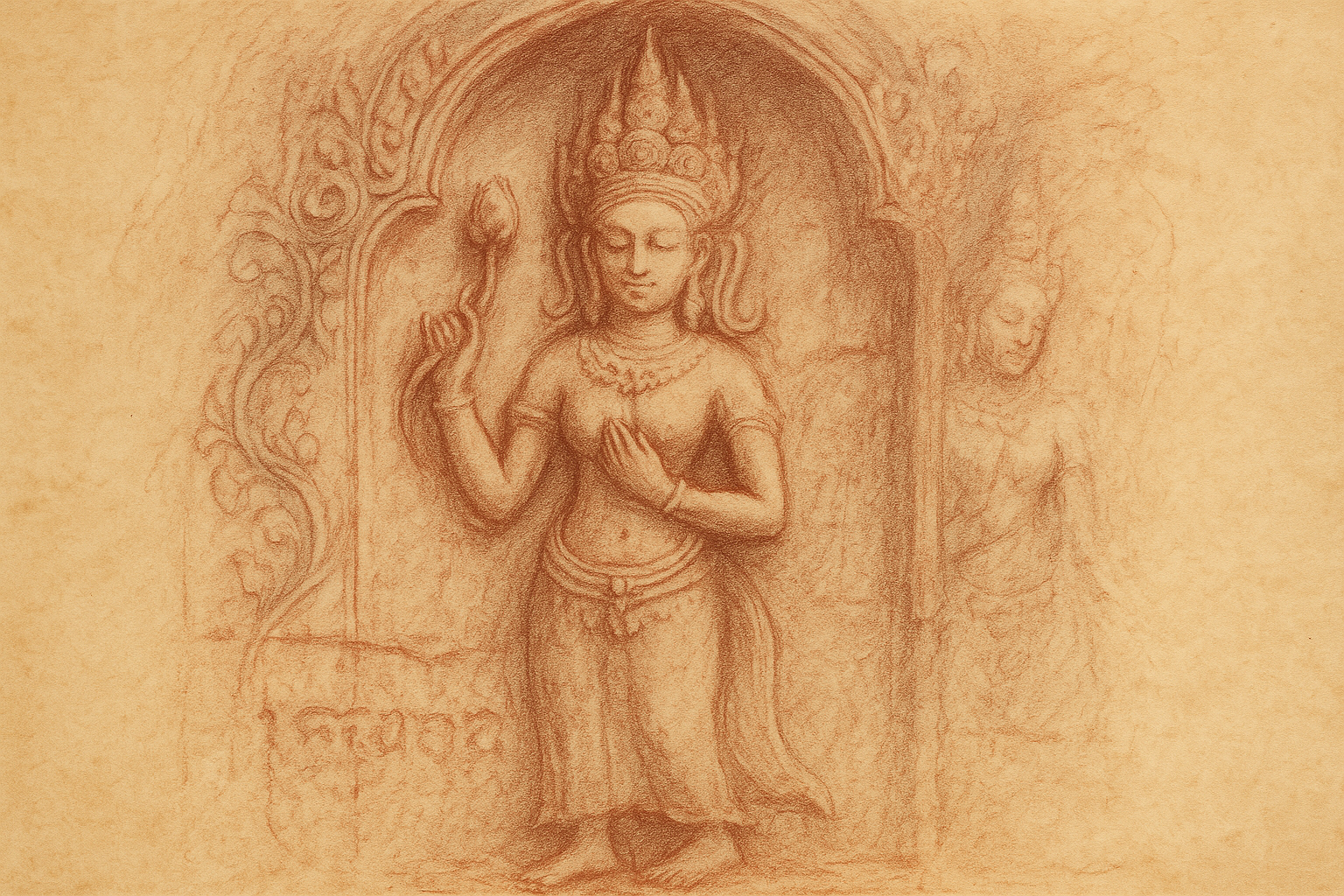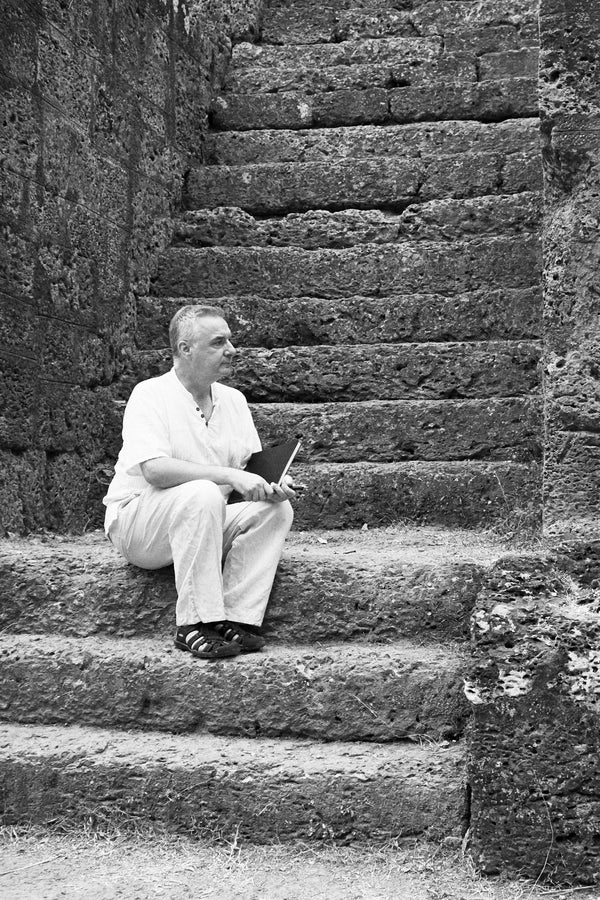Complimentary worldwide shipping on orders over $400 · No import tariffs for most countries
Complimentary worldwide shipping on orders over $400 · No import tariffs for most countries

What the Celestial Ladies Are Called
Sanctuary of Meaning · Artist’s Journal
Lucas Varro
They stand between worlds—
smiling into the stone wind—
neither named, nor known.
—
The heavenly maidens who grace the temples of Angkor are among the most beloved and recognisable figures in Khmer sacred art. Carved in high and low relief, thousands of them line the corridors, towers, and sanctuaries—from the great galleries of Angkor Wat to the quiet crown of Pre Rup. Their hair is crowned with floral diadems. Their fingers bloom with lotus buds. Their half-smiles seem to shimmer with secrets from another world.
Some lean toward each other in gentle communion. Others stand alone in stillness, as if listening inward. Their gestures are poised, serene, suggestive—never quite frozen, never fully explained.
We call them apsaras.
Or devatas.
Or sometimes, with reverent hesitation, both.
Of all the questions I’ve been asked while walking these corridors—by fellow pilgrims, collectors, dancers, and seekers alike—this one arises more often than I might have guessed:
“What’s the difference between an apsara and a devata?”
There was a time I answered with clarity.
Apsaras, I would say, are celestial dancers—mythic nymphs of Indra’s court, flying through sacred skies or caught mid-dance, radiant and playful.
Devatas are temple guardians—standing still, more solemn than seductive, more poised than joyful. They carry flowers or staffs. Their beauty is spiritual, their gaze composed.
In short: devatas do not dance. Apsaras never quite stand still.
That explanation once satisfied me. I even wrote a short essay titled You Say Apsara, I Say Devata!—in which I laid out the distinction and defended the devata’s quiet dignity. I suggested that apsaras were charming but light, while devatas were sacred and serious.
It all made sense.
Until it didn’t.
The seed of doubt took root one early morning at Angkor Wat, during a Buong Suong blessing ceremony. Apsara dancers stood beside saffron-robed monks, their movements slow, devotional, deliberate. Incense drifted skyward as their hands curved like petals in air. In that moment, far from being “trivial,” they seemed to carry the very spirit of the temple.
These were apsaras.
And yet, all within me whispered: devatas.
Later, I tried to explain the distinction to Doriane, who had stood beside me in silence during the ritual. But the more I spoke, the less sure I became. The words that once held conviction now felt thin.
There’s a simple rule I sometimes hold:
If a thing cannot be explained with quiet grace,
perhaps it is no longer needed.
We met again a few days later atop Pre Rup Temple, where the question first took root in me many years ago. I brought her to a quiet corner of the sanctuary, beside the southwestern tower, where the guardian lady Sarasvati still watches in stucco and brick. Four-armed, four-faced, she stands as the consort of Brahma—the goddess of speech and wisdom, one of the Sapta Matrikas, the seven mother goddesses of the Hindu cosmos.
She is not a dancing maiden.
Nor merely a minor deity.
She is not an apsara.
And she is more than a devata.
She is a goddess.
 Sarasvati, Pre Rup Temple, Angkor, Cambodia
Sarasvati, Pre Rup Temple, Angkor, CambodiaThis is the spot where my conversation with Doriane took place, next to the southwestern tower of Pre Rup Temple, watched over by the brick/stucco relief of Sarasvati, the four-faced, four-armed consort of Brahma.
Once, I would have pointed to her—and to her sister Varahi—as proof that the word “apsara” was too slight. But standing before her again, I felt something shift. The neatness of my earlier categories no longer served what I saw.
Three truths revealed themselves—quietly, like figures emerging from shadow.
First: Apsara is not a shallow word. It is ancient, luminous, and sacred. The Sanskrit apsarāḥ appears across Hindu and Buddhist texts for over three millennia. Though often translated as “celestial nymph,” it also means water spirit, cloud maiden, or radiant being of the heavenly court. The great apsaras—Urvashi, Menaka, Rambha—are not light-hearted myths. They are forces of presence. They move between realms.
Second: Devata is too broad. It refers to all minor deities—male and female, guardians and musicians, wind spirits and divine warriors. Apsaras themselves are one type of devata. To refer to all the celestial women of Angkor as devatas may be correct in taxonomy, but it lacks precision. And perhaps more importantly—it lacks poetry.
And third: the Khmers never made the distinction.
They have always called them apsaras.
Even today, the term carries all that is sacred, sensual, and symbolic about these celestial women. Some fly. Some dance. Some stand in pairs holding birds or flowers. Some smile shyly from alcoves. Others gaze directly from the walls with sovereign stillness. Their gestures nourish the stone with femininity, fertility, grace.
They are not all dancers—
but all of them dance—
with light, with time,
with the wind that lingers on carved stone.
And so, I have let go of the need to define.
I still use devata at times—especially when a figure calls for reverence or stillness. But I no longer feel bound by the division. Some of these ladies are apsaras. Some are devatas. Some are goddesses in disguise. And some, it seems, are only truly known by the silence they leave behind.
They stand between realms—
and whatever we call them,
they remind us that beauty
does not need to be categorised to be worshipped.
—
She does not tell you her name.
She simply opens her hands—
and the lotus blooms.
Celestial Grace: Apsaras of Angkor
Photographs from the Spirit of Angkor series by Lucas Varro
“They were never carved by the hands of men!
They were created by the Gods—living, lovely, breathing women!”
—Pang, 17th-century Cambodian poet
Without the apsaras, the temples of Angkor would speak in stone alone. It is these celestial dancers—carved in endless variations of grace, mystery, and joy—who draw breath into the stone, transforming solemn sanctuaries into radiant realms of divine presence. Their gestures are not stillness, but suspended movement. Their smiles are not fixed, but eternal.
In Khmer cosmology, the apsaras were sky-dwellers—attendants of the gods, embodiments of beauty, dream, and sacred rhythm. Their presence on temple walls was no ornamentation, but invocation. They were carved to welcome the gods, and by extension, to guide all who entered—bathing the pilgrim’s path in a sense of heavenly arrival.
In this collection of fine art photographs from the Spirit of Angkor series, Lucas Varro turns his lens toward these divine figures with the eye of reverence and the patience of prayer. Captured on medium and large format black-and-white film, shaped by chiaroscuro and hand-toned with care, each image reveals the quiet spirit within the stone—the breath behind the smile.
These limited edition prints, offered on hand-toned archival Hahnemühle Bamboo paper, are accompanied by a Collector’s Print Package including poetic writings, curatorial texts, and artist’s field reflections. Each one invites you not only to witness—but to be welcomed.
To enter this gallery is to step, as the ancients did, into a palace of the gods. And the apsaras are waiting.
Join My Studio Journal
Receive occasional letters from my studio in Siem Reap—offering a glimpse into my creative process, early access to new fine art prints, field notes from the temples of Angkor, exhibition announcements, and reflections on beauty, impermanence, and the spirit of place.
No noise. No clutter. Just quiet inspiration, delivered gently.
Subscribe and stay connected to the unfolding story.

Join My Studio Journal
Receive occasional letters from my studio in Siem Reap—offering a glimpse into my creative process, early access to new fine art prints, field notes from the temples of Angkor, exhibition announcements, and reflections on beauty, impermanence, and the spirit of place.
No noise. No clutter. Just quiet inspiration, delivered gently.
Subscribe and stay connected to the unfolding story.











































